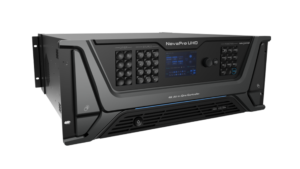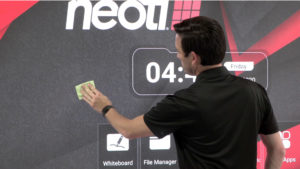Frequently Asked Questions
What does LED display mean?
A Light emitting diode display. This type of display is made up of an array of LEDs mounted directly onto a circuit board
What is the difference between an LED and LCD display?
LED displays are made up of dense clusters of LED lights whereas LCDs, or liquid crystal displays, are made up of a liquid resting between two panels. LCDs require a backlight, which are sometimes made up of LEDs, to produce illumination. LED displays often have brighter colors and higher contrast ratios than LCDs. LED displays are also modular, allowing for true curved designs.
Is a curved screen better than a flat screen?
Curved screens have a wider field of view, making the screens seems larger than they are. They don’t have as many reflections as flat screens, and allow viewers to feel more immersed.
What is direct view LED?
Direct view LED is a display type involving the use of light-emitting diodes mounted directly on a printed circuit board.
What is pixel pitch?
![]()
Pixel pitch measures the shortest distance from the center of one RGB pixel to the center of the next. Smaller pixel pitch means higher resolution within a given surface area. Along with display size, the most significant factor in determining the appropriate LED pixel pitch for a particular project is viewing distance. Viewing distance measure the distance of the viewer from the screen itself. The closer the viewer is to the screen, the smaller the pixel pitch needs to be to produce optimum results.
How do you install a video display wall?

We suggest having a video wall professionally installed because they need to be measured, mounted with rails and anchors, tuned, and calibrated.
How do you set up a video wall?
Setting up a video wall depends on configuration. Walls can have varying shapes, sizes, and number of screens. A controller can be attached to the back of each video panel and will allow images to be spread across the screens.
What is a video wall controller?

The controller (also called a processor) is the piece of hardware that sends your video signal(s) to the LED video wall. The controller is also responsible for managing the arrangement of each panel so that the video appears to occupy one seamless display rather than being sent to individual panels. Controllers allow for scaling as well as other settings and adjustments that can be made to the LED wall.
How do you clean an LED screen?

Wipe your LED screen gently using a dry microfiber cloth. Don’t spray water directly onto the screen and don’t use abrasive fabric, paper towels, or tissue to wipe down the screen because they may cause scratches. You may spritz a small amount of water onto the microfiber cloth for stubborn smudges.
How do you install a video display wall?
We suggest having a video wall professionally installed because they need to be measured, mounted with rails and anchors, tuned, and calibrated.
Also known as dot pitch, pixel pitch is distance between LED clusters in millimeters. The density of the clusters influences a screen’s resolution. The lower the pixel pitch, the smoother the details of an image are. Viewers can sit or stand closer to screens with low pitches.
What is the difference between HD, UHD, 4k and 8k?
The k in 4k stands for kilo, or thousand, meaning that 4K is a resolution with approximately 4,000 pixels.
What does IP Rating mean?
IP ratings, also known as International Protection Markings or Ingress Protection Markings, are detailed by the standardized IP Code published by the International Electrotechnical Commission (IEC). The rating system was developed to classify the degree of protection that electrical systems have against different types of ingress, including dust, water, and accidental contact.
What is moire?
A quick and easy explanation of moiré is a visual deformation caused by overlapping lines. Improperly photographed LED panels can appear to have wavy lines due to the individual light sources on the display. Techniques exist to reduce and eliminate the moire effect.
